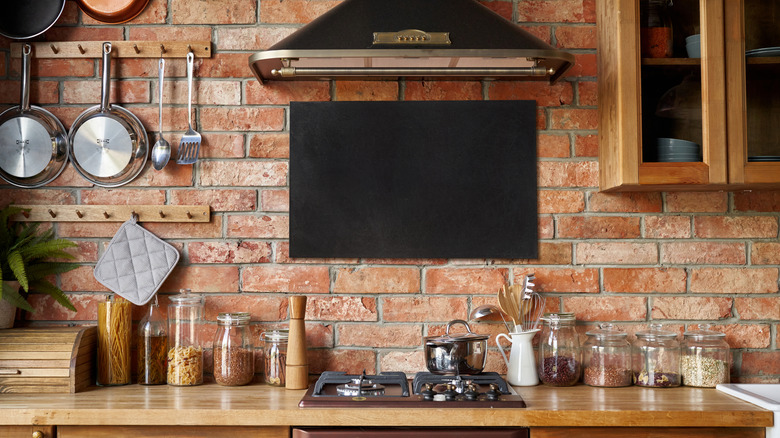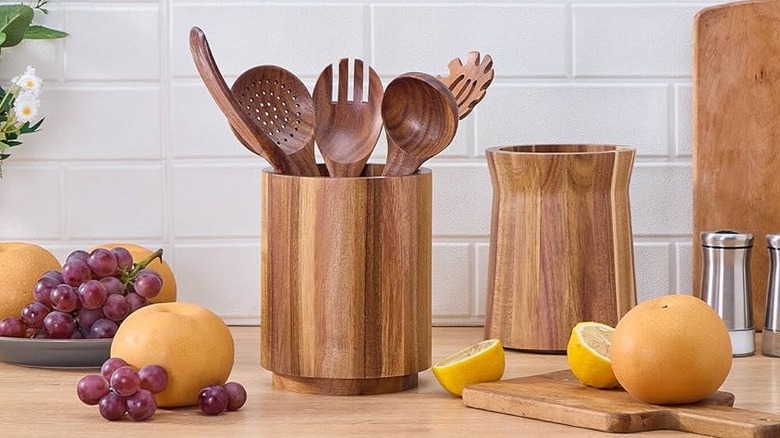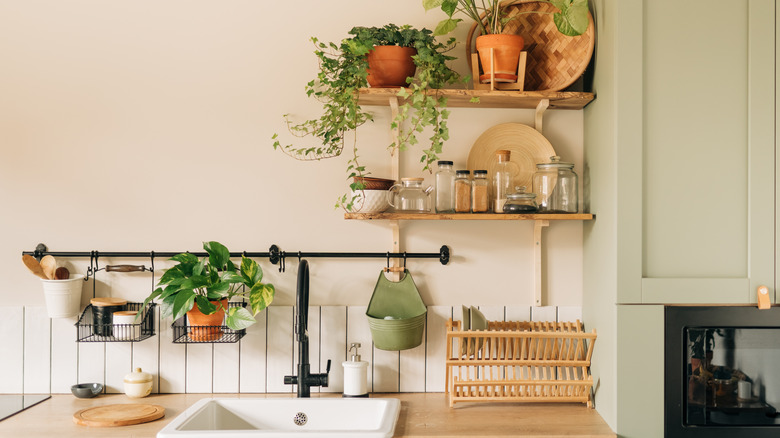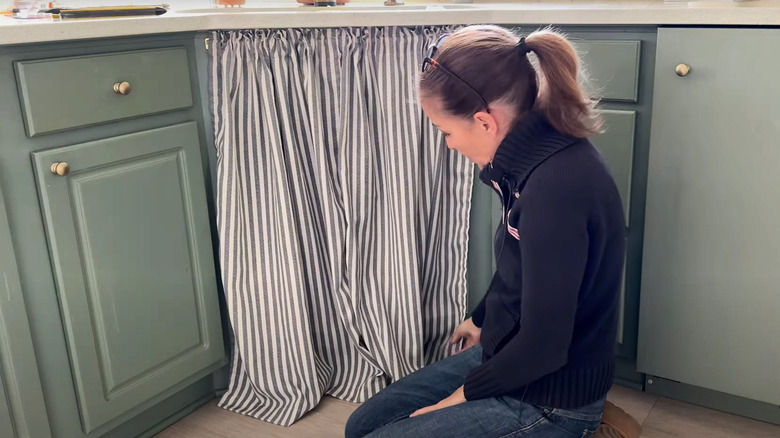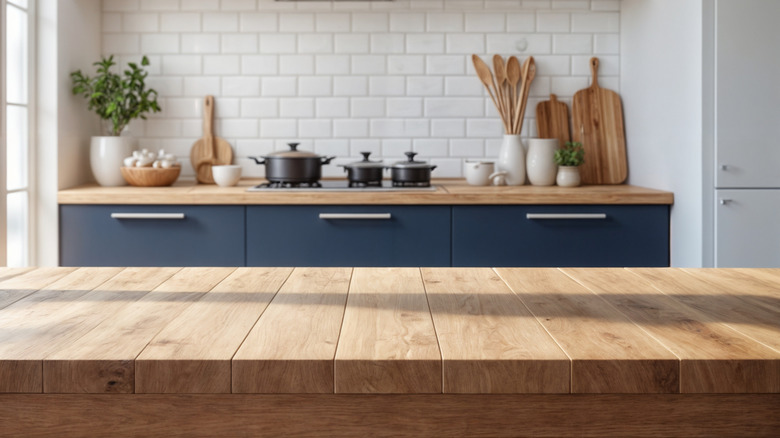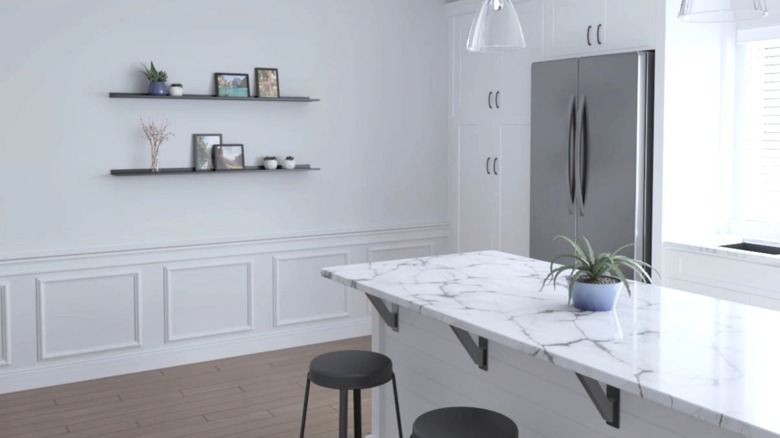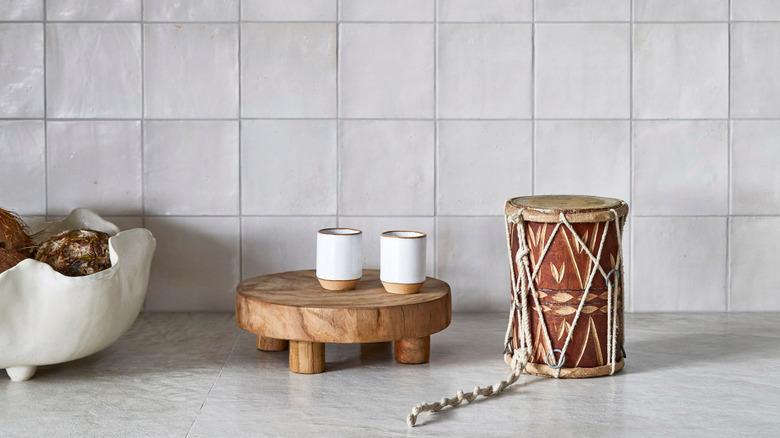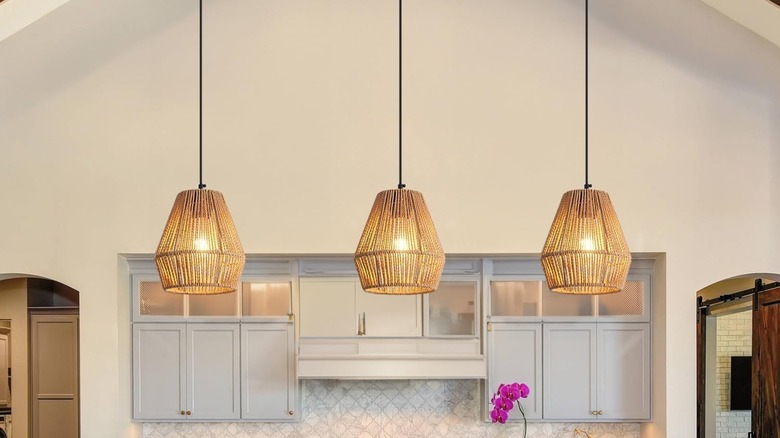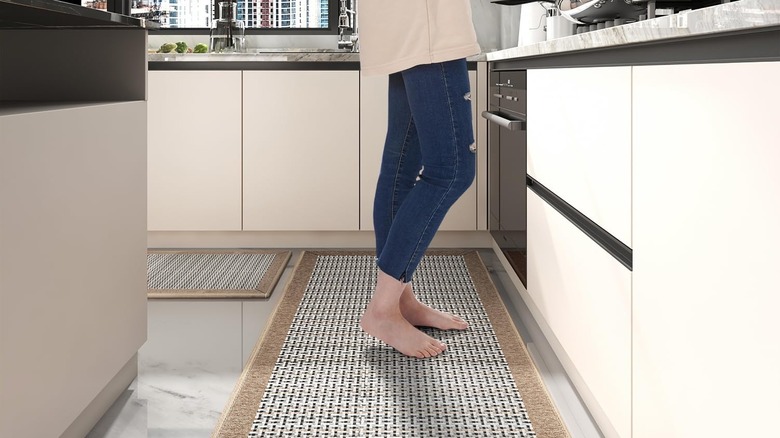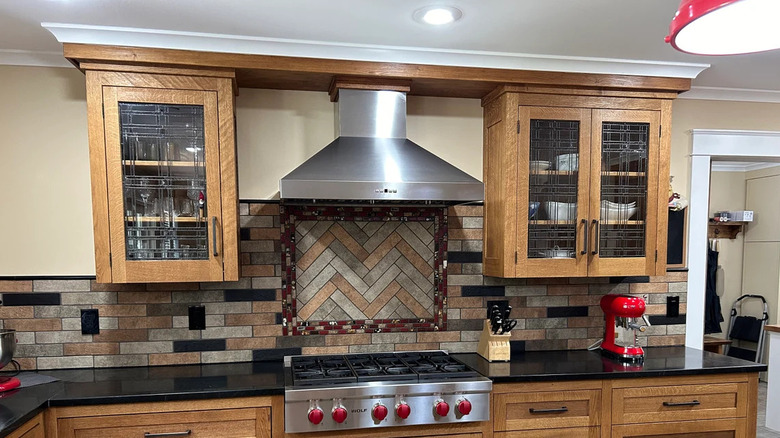9 Ways To Refresh Your Kitchen By Adding Texture
We may receive a commission on purchases made from links.
The interior design world is finally abandoning minimalist trends for decor that has more depth and complexity. When it comes to the kitchen, think fewer flat, stark finishes, and more timelessly tactile elements. An intentional interplay of textures is one of the things that sets designer-esque interiors apart from builder-grade ones, and the last couple of years have seen a swing from ultra-slick kitchen spaces towards ones with character and charm. Cottagecore kitchens are taking over TikTok, and HGTV stars are continually turning up the texture in kitchens, whether through imperfect zellige tile, rattan accents — you name it. Champalimaud Design principal Matoula Karagiannis told Luxury London, "Handcrafted, warm, emotional touches are appearing more in design. It's a lot less clinical, with wood and layered textures creating a calm and serene atmosphere." Since dynamic styles are growing in popularity, now's the perfect time to give your simple kitchen design a facelift with textured decor.
What's more, there are plenty of DIY projects and professional installations that can help you revamp a flat and cold-feeling space. Adding natural stone, wood, woven fabrics, and other decor creates more points of interest and enhances tactile appeal. To help you add warmth and depth to your kitchen, below we cover nine ideas for creating a more designer-grade and nuanced space by leveraging texture. Most of the projects below allow you to add texture to your kitchen without spending a lot of money. Others require a larger outlay, but if you're busy planning a kitchen remodel, now is the time to think about how to layer in texture through the materials you choose.
Mix different pieces of wood kitchen decor, utensils, and furniture
One of the easiest ways to add warmth and texture to a kitchen is by incorporating wood decor and furniture pieces. Hardwoods tend to have prominent grain patterns, ideal for adding visual texture to rooms. Hardwoods are also a better option for hardworking items like chopping boards and cooking spoons. By mixing wood species and finishes (think, a glossy varnished wood tray and a raw wood bowl paired together) you can create a contrast of textures.
There's a plethora of ways to combine wood decor in the kitchen. Freestanding wooden cabinets, barstools, kitchen chairs, and displays of wood or bamboo utensils can all add a rustic and homey touch to kitchen interiors. This tip is doable on a small or large budget. If you're ready to renovate, you could look into installing butcher block countertops (more on this below), oak cabinets, or hardwood flooring. But if you want to go the easier and more affordable route, simply add wooden accents where you can. For instance, you can put one of these Clould Mason Acacia Wood Serving Trays on your counter and position another wooden decor piece, such as this Lohoner Acacia Wood Utensil Holder, on top. You can outfit kitchen cabinets and drawers with something like the Antrader Drawer Pulls, fit them out with wooden or bamboo cutlery trays, style your kitchen island with a larger wooden fruit bowl, invest in a wooden breadbox, etc. If you're worried about going overboard with different wood species, follow these clever tips for perfectly mixing wood tones to strike the perfect balance. To ramp up the textured look even further, keep an eye out for pieces that contain other natural materials as well, such as wooden barstools with cane webbing seats, or a wooden cabinet with webbing in the doors.
Add indoor houseplants to open counters, shelves, or windowsills
There are lots of houseplants that are perfect additions for kitchen windows and well-lit countertops which can also provide a variety of interesting textures. For instance, some Peperomia plants (like 'Silver Frost') have fleshy, rubbery-looking, crinkly leaves. African violets and gloxinias have slightly fuzzy, velvety leaves and Haworthia 'Universe' succulents have rough, ridged ones, while thyme has dry almost dusty-looking, fine foliage. And while we're on the topic of thyme, yes, you can grow it on a windowsill, as long you avoid these kitchen herb garden growing mistakes. Give them enough light, and a few small herb plants can add function as well as complexity to your interior design.
Speaking of light, make sure that any species you choose will handle the light levels they get in your kitchen. Sun-loving plants won't do well in a dim corner, and shade-loving ones won't be happy on a hot windowsill. If you want to place a few plants together to create contrast, make sure they all enjoy the same amount of light. A good example is ZZ plants with their shiny and narrow upturned leaves and pothos with their vine-like, heart- and oval-shaped foliage. Neither of these species like direct sunlight, making them great neighbors. If you don't have a green thumb, you can always opt for imitation plants too. The MyGift Modern Tabletop Set of Planter Pots emulates a snake plant, arrowhead plant, and parlor palm, and brings complexity to your home without any additional responsibility. If you have the space, a real or imitation olive tree (we'd recommend the Nearly Natural Silk Olive Tree) could add some organic softness to a bare and blank corner. To channel even more texture, consider placing your plants in round baskets to hide the plastic nursery pots, or opt for terracotta planters.
Install a cottagecore sink skirt beneath a farmhouse sink
While still an unconventional choice, sink skirts are making a comeback. Designer Becky Shea recommended them for country-style kitchens during an interview with Real Simple, saying, "Beyond its functionality, a skirted sink is a wonderful way to introduce texture into a space that might otherwise be dominated by millwork and stone, adding softness and warmth to the design." An under-sink curtain brings depth and coziness, and is especially suited to English, French country, and rustic-themed homes. Traditional sink skirts tend to sport striped, gingham, floral, or other vintage-inspired patterns that give them an old-time feel.
Most sink skirts are made of textured fabrics, ranging from beige roughspun linens to ruffled denim designs. Buyable options are a little limited (you probably won't find anything at a place like Wayfair or Pottery Barn), but you can find options on Amazon (such as this peel-and-stick Dependable Industries Fabric Sink Skirt) and if you know how to sew, you can DIY a curtain pattern. All you need is adhesive Velcro strips or a rail to attach it to, sewing supplies, and the fabric of your choice. If you make it yourself, the textural opportunities are endless. Choose between cotton, silks, velvets, and more, in any color or design to enhance interior styles beyond rustic farmhouses. Not keen on sewing? You can also modify a small curtain, such as this set of striped Jinchan Linen Kitchen Curtains, which are 36 inches long (the height of an average kitchen counter). With a liquid stitching product (aka fabric adhesive) you can hem up the bottom if they're too long. Whichever method you choose, you'll also need something like a café curtain rod (Wayfair sells this set of two Evideco Adjustable Café Rods). Altogether, installing a sink skirt shouldn't cost more than $50, but you may have to remove some pre-installed cabinet doors to make it work.
Replace kitchen countertops with leathered stone or butcher block
Countertops are one of the largest focal features in kitchens, and changing them can really refresh your design. Butcher block has natural beauty and, depending on the wood species, stain, and finish, can be incorporated into various interior design styles. The same rules apply to natural stone, and it has a lot of flexibility based on the type, color, and finish.
Butcher block counters are made of hardwood, which is convenient since hardwoods have more variation and graining on their surface. If you go with butcher block, you'll have the choice of end grain or edge grain. End grain butcher block may add more visual texture and is best for directly chopping on, but is more expensive. Edge grain is more affordable and still delivers visual warmth and natural variation. Also, keep in mind that you don't have to do your whole kitchen in butcher block. You can opt to just do the island (or another suitable area), and have the rest in stone. For stone slabs, choosing the right finish is key to adding dimension to a kitchen space. Instead of selecting conventional, highly-polished options, take the creative route and choose a deliberately textured finish, like honed, brushed, brush-hammered, sandblasted, or leathered. Besides adding a sense of softness to your kitchen, these textured finishes can also reduce glare on countertops.
Changing your counters doesn't have to be a multi-week renovation project, and it is possible to bring new life to a kitchen without replacing or painting the countertops. Instead, consider getting a granite or quartz overlay with your desired finish. This process is faster, more affordable, and has plenty of design options. The potential downside is that you can't install an overlay if the base countertop and cabinets are too flimsy. Expect to spend about $60 to $80 per square foot for granite, and around the same amount for quartz. Keep in mind that prices can vary widely depending on your chosen style, colors, and professional rates in your local area.
Jazz up your walls with paneled wainscoting, picture frame molding, plaster, or limewash
If your kitchen feels flat, the walls are another impactful area you can upgrade, and there are lots of ways you can add texture to them. Wainscoting is a decorative wall paneling method that's been around for centuries and home design celebrities like HGTV's Joanna Gaines use this easy way to bring texture into a boring room. Picture frame molding is another option to consider that can add additional texture, especially if you opt for something with a more ornate trim profile. Both of these options are ideal for more historic homes where wall molding and paneling will fit right in with the architecture. Of course, putting wainscoting or picture frame molding in a kitchen is only possible if you have open wall space. It makes a great addition to kitchens with breakfast nooks. Either DIY or hire a professional to add texture to your kitchen with wainscoting. Build it yourself by adhering wood paneling, beadboard, or vertical shiplap to the lower half of your wall, or by mounting trim in evenly spaced rectangular shapes to create picture molding. An easy way to execute this is by using a kit like Art3d's Pre-cut Wall Molding Set. The three-piece set is only $74.99 and covers about 110 square feet, but you may need to order more depending on how much wall there is to cover. In comparison, a professional wainscoting job costs over $1,500 on average for a 100-square-foot area.
If you're after a less Victorian, more imperfect look, plaster or limewash are two other ways to add texture to the walls of your kitchen, both of which can contrast nicely against shiny metallic finishes on things like stainless steel appliances. Limewash is relatively easy to apply and is suited to high-humidity environments like kitchens. It pairs well with a range of spaces from eclectic to traditional and contemporary, offering a matte, pleasingly soft, dusty-looking, and irregular finish. Applying plaster can require more finesse, especially if you're a little bit of a perfectionist — even when the desired result is a slightly imperfect effect — but still doable with some patience and practice.
Install a textured tiled backsplash
Got plans for installing a new backsplash? This is another great opportunity to channel some extra texture. A lead team member at Clay Imports, Anna Lood, told Elle Decor, that tile "is such an effective way to bring texture, movement, and life into a space." Select tiles with a contrasting sheen to other items in your kitchen, or choose a deliberately rough finish like brushed, multifired, textured, or tumbled. Handmade tiles and zellige tiles can also add texture through their slight irregularities. Penny tile backsplashes can give off a pebbly appearance, and basket weave tile designs can create the illusion of soft texture, even if their surface is primarily flat. Finally, both brick tiles and rustic stone backsplashes can add a rugged effect to contrast against more sleek finishes.
You can opt for a professionally installed kitchen backsplash or take the budget-friendly DIY route. Peel-and-stick tiles are the easiest to apply, but there aren't all that many options that add texture. If your backsplash tends to stay relatively clean, you can try Sunwings Peel-and Stick-Mosaic Natural 3D Stone Tiles which customers claim, "feel like real stone." A word of warning: Backsplash tiles that are more irregular, rough, or have raised edges can be harder to clean. If you're worried about gunk and cooking grease building up, consider installing more textured tile options away from the range and primary food prep areas, such as above a coffee bar.
Pick woven lampshades for hanging pendant lights
Embellishing a kitchen with woven elements, like bamboo, jute, rattan, reed, and willow materials, is a great way to ramp up variation in your space. Add a touch of texture with a "Fixer to Fabulous"-inspired upgrade and install or replace your kitchen pendants with wicker-style lampshades. Woven materials are often associated with coastal and boho-style rooms. However, woven pendant lights are usually a neutral color and come in various shapes and sizes, making it easy to integrate them into any room, from modern ones that need a touch of wabi-sabi character, to transitional spaces. Wicker meshes well with stone and wood finishes since all three are natural materials.
Choosing the right size, design, and number of wicker pendant lights is key to making the look work in your kitchen space. Larger light fixtures will make more of a statement, and if you have high ceilings, oversized woven pendant lights can help to fill out the space. If you're hanging multiple pendant lights across an island, aim to span them about 30 inches apart. Dome-shaped lights tie in with country- and industrial-style rooms, while round and cone-shaped lights can be better for contemporary, minimalist, and modern rooms. Woven chandeliers with rafia-style fringes and japandi-inspired looks can add even more texture and are perfectly suited to suit boho, organic modern, and eclectic interiors. Pay attention to any metal embellishments on the light since these extra details add dimension. If the metal hardware is prominent, you may want to pick a metal color that matches other kitchen fixtures.
Alleviate cold, hard floors with textured kitchen rugs
Don't forget the floors when enhancing a kitchen's appearance. Woven rugs made from materials like bamboo, jute, sisal, wool, vinyl, and polyester blends can add a lot of textured appeal in kitchens and warm up the space. With a bit of shopping around, you can find a rug to work with just about any interior style, thanks to the multitude of designs to choose from. Jute rugs are ideal for organic modern homes or even modern farmhouse spaces and can add tons of texture. Persian-style rugs are popular for transitional kitchens, and add a fuzzy silkiness underfoot. Cotton rugs come in a vast array of patterns and can be found in tightly woven designs (which is important for a kitchen) that still add subtle softness to your floor. If you experience discomfort from standing, consider using rubber or vinyl anti-fatigue mats with etched patterns and beveled edges. The raised designs are plush underfoot and securely cling to hard kitchen floors.
When it comes to woven designs, avoid tassels and fringes, as these can easily get tangled with food and debris. Look for sturdy and tightly woven materials that have easy wash instructions along with them, such as this Artoid Mode Washable Non-Slip Kitchen Rug and Mat set. These kitchen rugs are made of a machine-washable chenille polyester blend and have a rubber backing that makes them practical for kitchen areas. If you find a woven rug without any backing, use a Gorilla Grip Felt and Natural Rubber Rug Pad to make it safer for kitchen areas. If anti-fatigue mats better suit your needs, pick a 3D pattern like Chef Gear's Anti-Fatigue Gelness Kitchen Mat, which comes in various colors and is easy to wipe clean.
Restyle cabinetry by adding more decorative doors and textured hardware
Cabinetry is one of the main attractions in a kitchen, and you don't have to rip out and replace it to add textural elements. Change up the look with additional trim, upgrade the doors with glass, or swap out the hardware with more ornate designs. It takes thousands of dollars to remodel kitchen cabinets. It's much cheaper to add new doors without replacing the entire cabinet. You can purchase pre-made door styles with beadboard, glass, louvers, or raised and recessed panels. Alternatively, instead of replacing the doors, you can also look into installing ornate trim in designs like beaded, carved, egg and dart, embossed, roped, and more. If you love the look of fluted cabinet finishes, you can even adhere half-round trim or pole wrap across the entire surface of certain cabinet doors, or across the back of an island.
And if you don't feel like replacing doors or nailing on trim, one of the easiest ways to add texture to cabinets is by changing out simple knobs and handles for more exciting, tactile hardware. Look for distressed, etched, hammered, and ribbed designs with antiqued, brushed, and patinaed finishes. Products like Amerdeco Brushed Satin Nickel Knurled Cabinet Pulls are a good fit for contemporary kitchens. Be more adventurous with something opulent like YCSJ's Round Kitchen Cabinet Bronze Knobs With Plates if you have a country-esque setting or a very traditional space.
